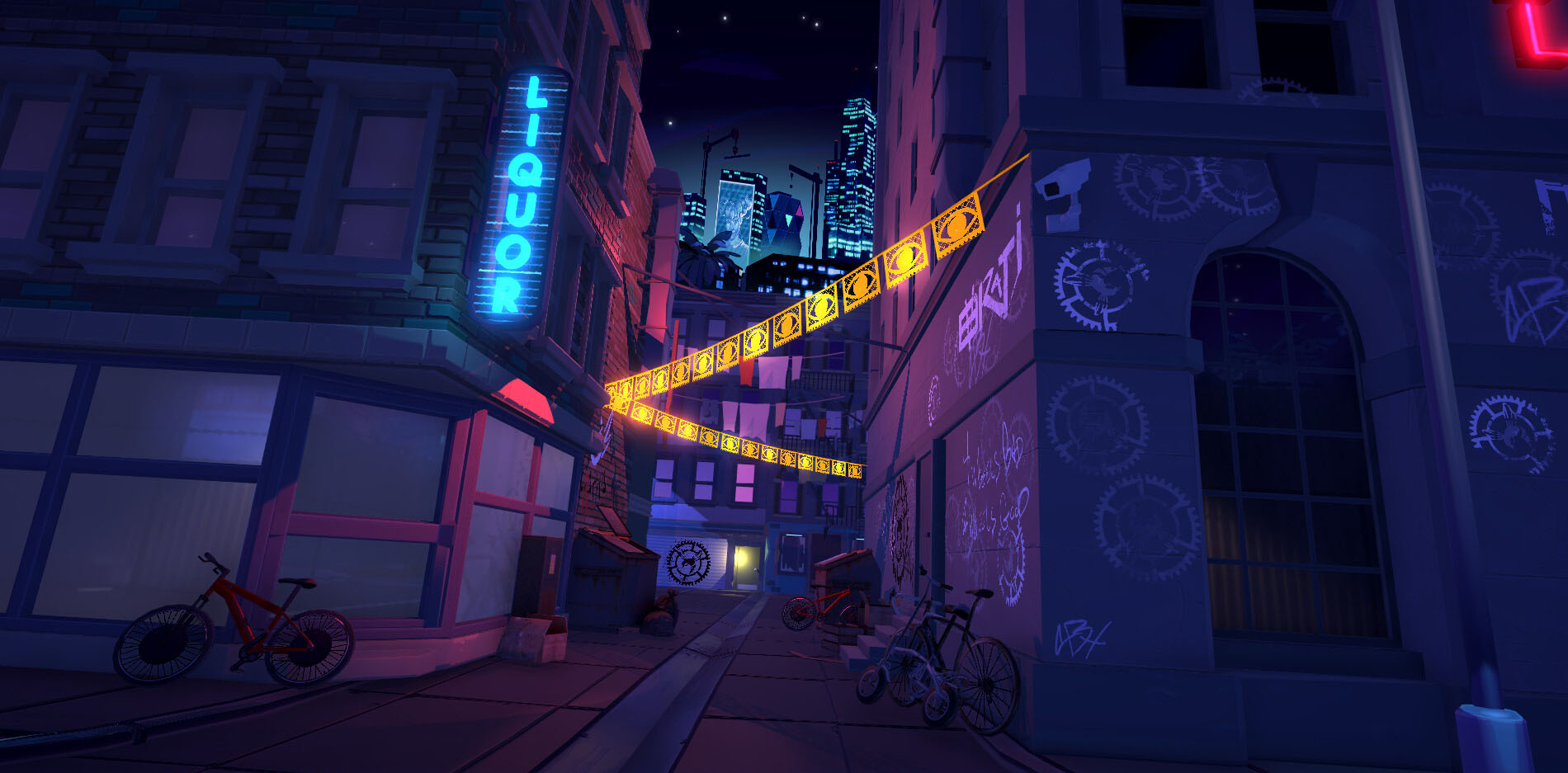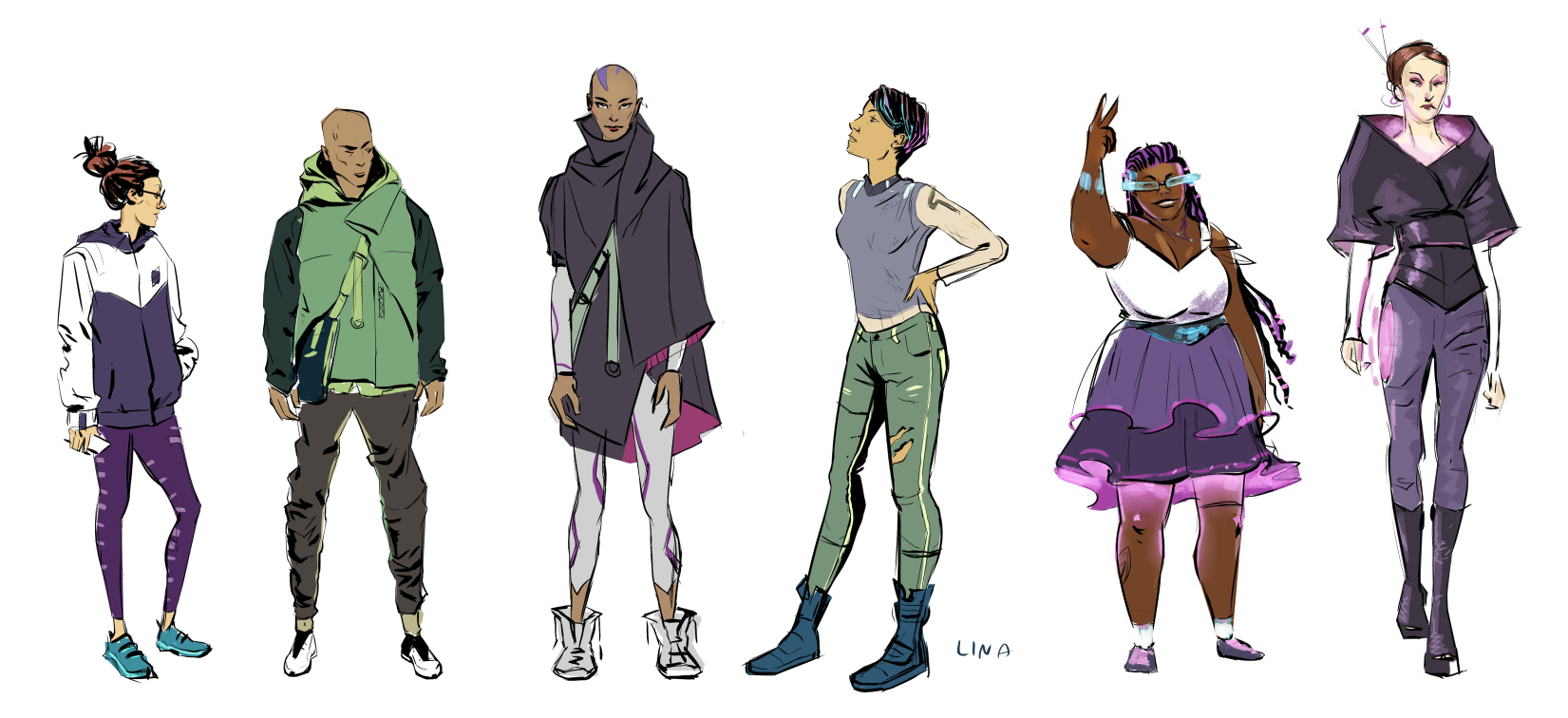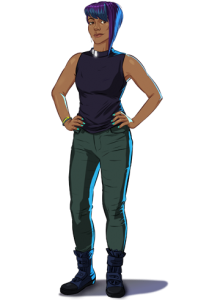The scenery drips in hues of blue and purple and practically everyone has at least one accessory that glows. Occasionally, you’ll spot someone with a robotic arm. All these unique quirks and features give Neo Cab its cyberpunk vibe. However, underneath those cyberpunk trappings is a world that still feels personal and down-to-earth thanks to its protagonist.
In an increasingly automated world, Lina is one of the few human rideshare drivers that remain. Now her best friend, Savy, has gone missing and it’s up to her to investigate.
Cliqist talked with Neo Cab creative director Patrick Ewing about what makes Chance Agency’s new title an emotional survival game. During that meeting, he also discussed the futuristic setting they made for the game.

A promotional scene made by environment and 3D artist Lisa Fleck. Art direction by Vincent Perea.
A Different Punk Vision with L.A. Inspiration
When asked about more traditional cyberpunk themes, Ewing’s response was prompt:
“We wanted to break them.”
In fact, Ewing described Neo Cab as more “nowpunk,” saying that it focused on drawing out a little of 2019 into the future, and finding that alone was strange enough. While Ewing said the game wants to explore the possible outcomes of runaway technological development, the team wanted to keep things from getting too bizarre.
“Didn’t want to go to super weird places or the cliches like noodle shops everywhere and arbitrary Kanji characters,” Ewing said.

Concept art by art director Vincent Perea.
Part of that desire resulted in the fictional setting of Los Ojos. Sometimes abbreviated to L.O. in the game, Los Ojos is ethnically similar to its real-life counterpart, Los Angeles. Ewing described Los Ojos as a similar melting pot, with various influences like Mexican, African, Central Mexican, and Asian cultures.
“I should note that we’ve imagined Los Ojos to be a very culturally diverse city,” wrote art director Vincent Perea in a dev log post. “It was important to me that the design of the pax [passengers] represented a wide range of ages, ethnicities, and body types.”
Ewing shared that it took a while to figure out Los Ojos. The team had thought of other places for inspiration—like San Francisco—before settling on an analogue to Los Angeles. However, he added that a lot of tech culture in Neo Cab is still based on San Francisco.
Pax Tales
Though Ewing had said Neo Cab wasn’t meant to be too bizarrely sci-fi, I assumed it had some sci-fi lingo slipped in when I saw Lina refer to passengers as “pax” in the E3 demo. At least until Ewing informed me that “pax” was part of the real lingo that Uber and Lyft drivers use.

Though Lina drives for a different company now, she worked for Capra before. That ended when Capra began replacing their human drivers with automated cars.
While there is a little bit of sci-fi lingo in Neo Cab—for example, there’s slang for traditional or non-automated cars—Ewing said they often held back, feeling that too much of it would end up becoming distracting.
Ewing also shared that the team talked to several Uber and Lyft drivers when making the game.
“[We] very quickly learned that holy shit, they have a million stories,” Ewing said.
They didn’t utilize the real stories in the game. However, Ewing admitted that they provided another source of inspiration for the team.
With the ridesharing app in Neo Cab’s story, Ewing explained that they tried to model its functions and its pay systems after ridesharing businesses in real life.
The world has other sci-fi adjustments. Lina worries about paying to charge her car instead of concerns over gas. The technology may differ, but the core concept hasn’t changed.
Story-Driven Aesthetics
“Visually, we were inspired by the photography of Liam Wong, who kinda makes everything look like a beautiful cyberpunk dream,” Ewing said, adding that it was probably Perea’s favorite color palette to work with.
Besides enjoying the colors in the demo, I noticed another interesting pattern. Every character I encountered wore something that glowed a stark white, like a piece of jewelry.
“[It was] one of the elements of future fashion that Vincent [Perea] wanted to bring in,” Ewing said.
It’s a cool, sleek visual that feels like a nice twist on the cyberpunk genre. There was also a story purpose behind it.

“Everyone wears lit up clothing so they don’t get run over,” Ewing said.
In the world of Neo Cab, automated Capra cars driving around led to the creation of glowing clothes that would catch their attention—or “defensive fashion” as Ewing called it.
Despite these implications, Capra officially boasts “unmatched” and “incredibly good” safety ratings. However, Ewing pointed out that some still question whether Capra cars are actually good at seeing humans, or just other Capras.

An automated Capra car made by environment and 3D artist Lisa Fleck, based on a concept by art director Vincent Perea.
Players will have a chance to find the answer to that question soon. They’ll also get the opportunity to help Lina investigate Savy’s disappearance. Neo Cab will be available this summer on the Nintendo Switch, and it’s scheduled for additional releases on Mac and PC.



